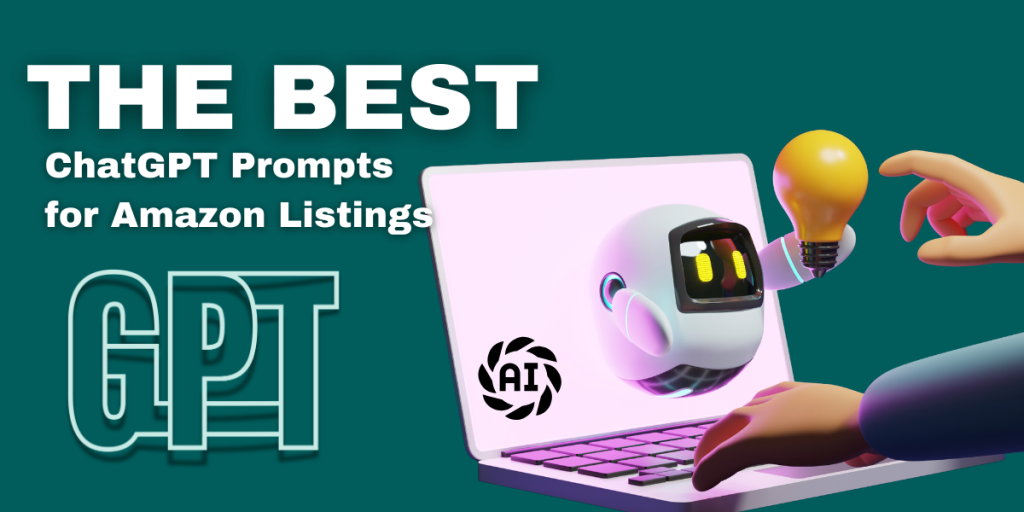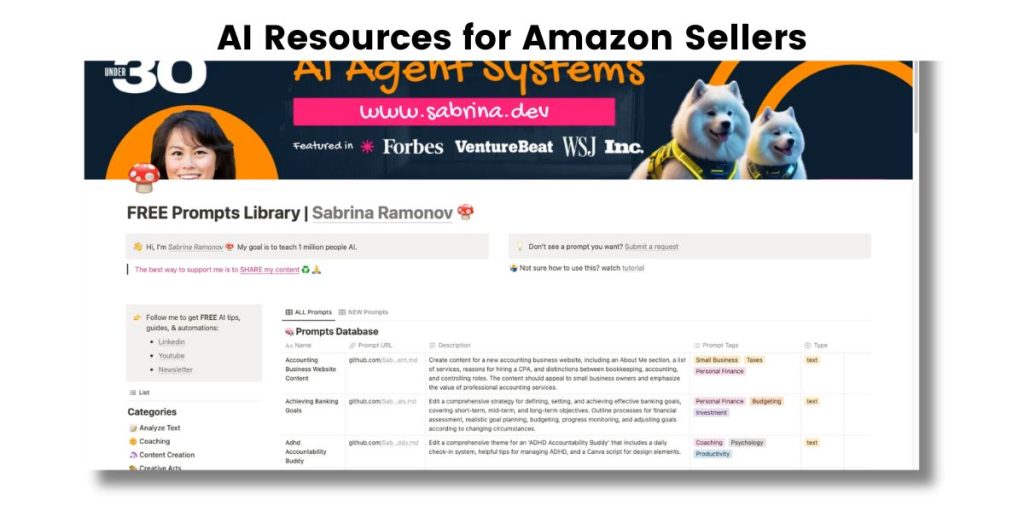ChatGPT Prompts for Amazon Sellers: How to Get Started Fast? ChatGPT is revolutionizing how Amazon sellers create and optimize their listings. As an AI-powered tool, ChatGPT can generate high-quality product titles, bullet points, A+ Content and even help analyze customer reviews—all in a fraction of the time it would take to do manually.
But here’s the thing: Your results are only as good as your prompts. Crafting effective prompts is essential to guide ChatGPT in producing compelling, compliant, and conversion-ready content.
This comprehensive guide is designed to help you create the best ChatGPT prompts for your Amazon listings. Whether you’re a new or seasoned seller, mastering these techniques will save you time and deliver impactful, optimized content to help increase traffic and conversions on the worlds largest online marketplace.

What is ChatGPT and Why Are Well-Structured Prompts Essential?
ChatGPT, developed by OpenAI, is a powerful AI tool capable of generating human-like text based on your instructions. From crafting compelling website copywriting, conversion-worthy Amazon listings and SEO-rich product descriptions to writing attention-grabbing captions, ChatGPT can streamline your Amazon business.
ChatGPT can only perform as well as your prompts allow. A vague or incomplete prompt will lead to subpar outputs, while a clear and structured one will deliver polished results tailored to your needs.
Writing well-structured prompts is the foundation for getting the most out of ChatGPT. Think of it as giving precise instructions to a team member—you’ll see better results when your directions are clear and actionable.
How to Train ChatGPT on Your Amazon Business
ChatGPT is a general-purpose AI model, so its default responses may not fully align with your brand or Amazon business goals. To get better results, you’ll need to “train” ChatGPT by providing it with relevant data about your business.
A great Amazon listing prompt is built on essential components that guide ChatGPT to deliver accurate and optimized results. Without these building blocks, your outputs may lack focus, clarity, or compliance with Amazon’s guidelines.

Incorporating these components ensures your prompts are clear, detailed and aligned with Amazon’s standards, paving the way for successful listings.
ChatGPT doesn’t automatically understand your unique product features, brand voice, or customer demographics and buyer psychology. Without context, its responses can feel generic, requiring significant tweaking. Training the AI with specific details ensures its outputs align with your business needs.
Step 1: Provide Business Context – Start by introducing your brand, target audience, and product details. For example:
“My Amazon brand sells premium kitchenware to busy home cooks aged 30-50. Here’s data on my products, customer reviews, and sales information.”
Step 2: Define Your Tone and Style – ChatGPT can match your desired brand voice. For example:
“Our brand uses an energetic yet professional tone, emphasizing innovation and sustainability”
Step 3: Share Specific Examples – Help ChatGPT understand your expectations by sharing examples of content you like. For instance:
“Here’s a product description I admire from [Competitor]. Write something similar for my brand.”
Step 4: Analyze Competitors
“Analyze the following competitor x product descriptions to understand a tone and communication style our brand identifies with.”
Step 5 Test and Refine Outputs
Run several prompts, provide feedback and tweak instructions to improve results over time.
Step 6 Save Effective Prompts
Document successful prompts so you can reuse or tweak them for future tasks.
Training ChatGPT may take a bit of time upfront, but it’s an investment that will pay off with tailored, high-quality listings that align perfectly with your brand.
ChatGPT Prompts for Amazon Seller Product Titles
Crafting Amazon product titles is all about balancing clarity, keyword optimization, and appeal. ChatGPT can help create high-converting titles, but only if your prompts are specific and structured.
Amazon Title Prompts:
Simple Title Prompt:
“Create 10 Amazon product titles for a ceramic hot air brush by Brushd Beauty. Titles must include the keywords ‘ceramic hot air brush,’ ‘portable hair styler,’ and ‘3-in-1 hot air brush.’ Keep each title under 200 characters.”
Competitive Analysis Title Prompt:
“Here are the top-ranking Amazon product titles for ‘hot air brush.’ Analyze them and create 3 optimized titles for my product. Use original content only.”
Best ChatGPT Prompts for Amazon Bullet Points and A+ Content
Bullet points are crucial for highlighting product benefits and addressing customer pain points and objections. ChatGPT can save you hours by generating concise, benefit-driven bullet points.
Prompts To Try:
Basic Bullet Points Prompt:
“Create 5 Amazon bullet points for a 3-in-1 ceramic hot air brush by Brushd Beauty. Focus on ease of use, portability, and styling efficiency. Target busy moms who value quick, effortless solutions.”
Competitor-Inspired Bullet Points Prompt:
“Here are the bullet points from top-ranking ceramic hot air brush listings. Analyze them and create 5 new bullet points that are optimized for conversion.”
A+ Content Prompt
“Write an A+ Content section for a 3-in-1 ceramic hot air brush. The target audience is busy moms. Highlight the product’s ability to save time, provide salon-quality results, and its portability. Use a warm, conversational tone.”
Step-by-Step Walkthrough: Crafting Amazon Listing Prompts
Crafting a great Amazon listing prompt doesn’t have to be intimidating. Breaking the process into simple steps ensures that every prompt is effective and actionable.
Step 1 Start with Context
“I sell eco-friendly yoga mats for women aged 20-40 who value sustainability.”
Step 2 Define Features and Benefits:
“Highlight the non-slip surface, lightweight design and use of recycled materials.”
Step 3 Add SEO Keywords:
“Include terms like ‘eco yoga mat,’ ‘non-slip yoga mat,’ and ‘sustainable workout gear.’”
Step 4 Set Tone and Style:
“Write this in a motivational tone that inspires a healthy lifestyle.”
Step 5 Request a Specific Output:
“Write a 200-word product description.”
Tips for Writing Clear and Specific Prompts
The key to great ChatGPT outputs is clarity. Ambiguity in your prompts leads to generic or inaccurate results, but a well-structured request ensures ChatGPT delivers exactly what you need.
- Be Clear About Your Goal:
Example: “Write five bullet points emphasizing the durability and portability of this product.” - Provide Examples:
Example: “Write a product description similar to this [insert example].” - Set Word Count Limits:
Example: “Write a product description in 150 words or less.” - Request Specific Formatting:
Example: “Write this in a five-point bulleted list suitable for Amazon.” - Iterate and Refine:
Run multiple prompts and tweak your inputs to perfect the output. - Save Your Work:
Save your most desirable prompts and store them for your next Amazon listing.
Staying Compliant with Amazon’s Code of Conduct and Style Guides
Amazon sellers must follow strict guidelines for listing content. Complying with Amazon’s code of conduct and style guides isn’t just about avoiding penalties—it’s about building trust with customers.
Amazon Compliance Prompts:
- Avoid Promotional Claims: Avoid language like ‘Best on the market’ or ‘100% guaranteed.’
- Stick to Factual Information: Focus on benefits that can be verified.
- Follow Formatting Rules: Keep bullet points concise and avoid special characters.
- Stay Family-Friendly: Ensure language is appropriate and aligns with Amazon’s content policies.
- Link to Resources: Use Amazon’s official style guide for detailed guidelines.
Compliance may feel restrictive, but following Amazon’s guidelines ensures your listings remain competitive, professional and penalty-free. Even experienced sellers can make mistakes when using ChatGPT. These missteps often lead to wasted time and suboptimal results. Avoiding these common pitfalls will ensure your prompts deliver effective and compliant content, saving you time and hassle.
- Being Too Vague:
Solution: Always provide detailed product information. - Ignoring Compliance:
Solution: Review Amazon’s style guides before finalizing your prompts. - Overloading Instructions:
Solution: Break down complex tasks into smaller prompts. - Skipping SEO Keywords:
Solution: Include 10-15 highly relevant keywords to boost discoverability.
Ensure ChatGPT’s Understanding Before Writing
Before diving into content creation, it’s essential to confirm that ChatGPT fully understands your request. AI models like ChatGPT excel when provided with detailed and specific instructions, but even the most advanced AI can misinterpret vague or unclear prompts. To ensure success, take a collaborative approach: treat ChatGPT as a virtual assistant that needs your guidance to deliver high-quality results.
Provide clear context and instruct ChatGPT to not write anything until it clarifies any questions.
Don’t write anything yet. Ask me clarifying questions until you are 95% confident you can complete the task successfully. Search the internet to retrieve up-to-date information.
Additionally, when working on complex tasks, break them into smaller steps. Instead of asking for an entire Amazon listing at once, request individual components like product titles or bullet points and review them before moving forward. ChatGPT’s iterative capabilities allow you to refine and adjust each step to ensure the final product meets your standards.
By taking the time to confirm ChatGPT’s understanding before moving forward, you minimize errors and streamline the content creation process.
Recommended ChatGPT Resources for Amazon Sellers

Becoming an expert at crafting ChatGPT prompts is a journey. Resources can help you refine your skills and stay updated on best practices.
Suggested Resources:
- Sabrina Ramonov’s Prompt Library: Your go-to guide for high-performing prompts.
- OpenAI Documentation: Deepen your understanding of ChatGPT.
- Amazon Style Guide: Stay compliant with Amazon’s requirements.
The Best ChatGPT Prompts for Amazon Sellers: Get Help From Christina Ink
Including these components in your prompts ensures that ChatGPT delivers precise, relevant and optimized content tailored to your Amazon listing and greater content marketing goals.
Crafting high-quality ChatGPT prompts is an essential skill if you want to optimize your listings, save time and increase conversions. By learning to be specific, clear and compliant, you’ll transform ChatGPT into a powerful assistant that produces compelling Amazon listings and engaging content.
By avoiding common errors, experimenting with advanced strategies and leveraging expert resources like Sabrina Ramonov’s prompt library, you’ll be equipped to create listings that meet Amazon’s standards and exceed customer expectations.
Now it’s your turn. Start practicing these ChatGPT prompts for Amazon sellers today, refine your prompts and watch your Amazon business thrive. And remember—success on Amazon starts with the right words. Let Christina Ink help you find them. Contact us today for help with your AI powered Amazon listing.

LIKE THIS ARTICLE?